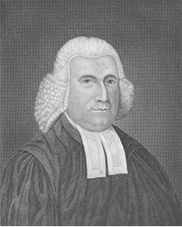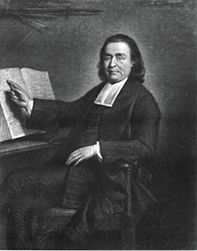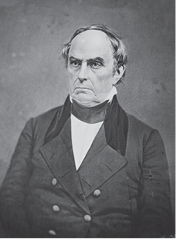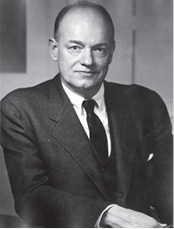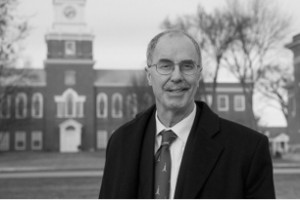Dartmouth is the ninth-oldest of America’s Colonial Colleges. Established in 1769, it was the last to receive its charter from the British Crown. Dartmouth’s founding has since become a matter of legend, at the center of which lies one man’s unlikely vision for a small school among New England’s wilderness. In the ensuing decades, Eleazar Wheelock, Samson Occom, and Daniel Webster, Dartmouth’s favorite son, have all emerged as larger-than-life figures. Learning about their lives is as integral to the Dartmouth experience as are partaking of DOC Trips, experiencing Winter Carnival, and relaxing across the Green. We herein present their stories, followed by discussions of Dartmouth’s various administrations, in what we hope provides a fundamental overview of our College’s celebrated history.
Eleazar Wheelock and Samson Occom
Wheelock’s sense of divine mission, which guided him to found Dartmouth, also drove his life’s many other pursuits. Born in Windham, Connecticut in 1711, Wheelock graduated from Yale in 1733 and was subsequently ordained as a preacher. Soon thereafter, he became caught up in the Great Awakening, a religious fever spreading throughout New England. The Great Awakening particularly influenced Wheelock’s sermons, which would regularly reduce audiences to tears.
One of Wheelock’s first pupils was Samson Occom, a young Connecticut Mohegan who was converted in heat of the Awakening. Wheelock helped him prepare for college until Occom’s weak eyes forced him to abandon his course of study. Occom then established himself as a schoolteacher in New London, later becoming a preacher and schoolmaster to the Montauk tribe of Long Island. He sustained himself and his large family through the manufacture and sale of wooden spoons, cedar pails, churns, and leather books, as well as through his missionary work.
His efforts in the latter role led Wheelock to conceive of a missionary school, for Indian as well as white students, in the heart of the Colonies. After receiving a £500 bequest from two young Delawares, and an equivalent donation of land and buildings from Colonel Joshua More, in 1754 Wheelock set up More’s (later “Moor’s”) Indian Charity School in Lebanon, Connecticut. The charity school was a pioneering enterprise, and it received support from such luminaries as George Whitefield, the famed Connecticut Revivalist, who donated a bell.
A decade after the school’s inauguration, Colonel More died, leaving the institution without its primary benefactor. To make matters worse, colonial interest in educating Indians was declining as a consequence of the French and Indian War of the late 1750s. Wheelock also proved unable to obtain a charter for the institution, either from the King of England or the Connecticut legislature. Financial hardship, meanwhile, only increased in severity.
The Royal Charter and The Earl of Dartmouth
Wheelock sent his former pupil, Samson Occom, to England in 1764 on a fundraising trip for the school. Wheelock was convinced that Occom’s preaching would be well received and that he would be successful at raising funds. Wheelock’s inklings were confirmed when, together with Reverend Nathaniel Whitaker, Occom collected approximately eleven-thousand pounds. It was an impressive figure for the time, especially given the deteriorating relations between England and the Colonies.
A number of prominent Englishmen contributed to the cause. Among them was William Legge, Second Earl of Dartmouth and Secretary of State for the Colonies. He was an admirer of George Whitefield and, by extension, of Wheelock and Occom. As president of the London Board for Moor’s School, he also managed to secure a £200 gift from the King.
John Wentworth, an American residing in England, was another key player. A recent appointee as Royal Governor of New Hampshire, he was eager to have the school relocate from Connecticut. His uncle, former Governor Benning Wentworth, had offered Wheelock 500 acres of land, to which John added the grant of an entire township. Wheelock accepted, and a royal charter was finalized in December 1769. Wheelock chose Hanover as the school’s domicile shortly thereafter.
Wheelock failed to adequately care for Occom’s family during his time in England, and, coupled with the planned change of location, this motivated Occom to part ways with Wheelock in 1768. Moreover, Occom likely anticipated the character of Wheelock’s new college as one primarily for whites, given Wheelock’s desire to avoid financial failure such as Moor’s Charity School had suffered. Occom’s affiliation with a cause he had served so well had come to an end. But indeed, so too had Wheelock changed the cause that he had promised Occom.
Wheelock intended to name his New Hampshire college Wentworth, but the Governor persuaded him to designate it Dartmouth, to gain England’s favor. Ironically, the Earl of Dartmouth, William Legge, lost interest shortly thereafter. He considered Wheelock’s new plan a perversion of the original.
The first building was a temporary log hut “without stone, brick, glass, or nails,” which served as a classroom and dormitory. In 1770, Wheelock was the College’s sole faculty member. John W. Ripley, Bezaleel Woodward, and John Smith joined him as tutors the following year. In 1771, Levi Frisbie, Samuel Gray, Sylvanus Ripley, and John Wheelock all became graduates of the College.
Dartmouth has produced a Class every year since, the only American college to do so, as the Revolution, the War of 1812, and other conflicts periodically disrupted studies at other institutions.
Daniel Webster and The Supreme Court
Wheelock designated his son, John Wheelock, as his successor upon his death, which occurred in 1779. John was only twenty-five when he became president of the College, and he seemed insufficiently qualified for the office. Hesitant to approve his posting, the trustees eventually relented, due in part to his willingness to serve without salary.
Eager to cultivate respect and support, the younger Wheelock proved too fervent in his efforts to govern the school, alienating students and the trustees. By 1809, opposition to Wheelock’s presidency took hold of the trustees, who slowly converted a majority of the professors to their point of view. After impeaching Wheelock in 1815, the trustees elected Reverend Francis Brown as his successor.
However, Wheelock, having no desire to yield, convinced New Hampshire’s Democrats to join him in his struggle against the trustees, whom he accused of various offenses against the College. New Hampshire Democrats, led by then-Governor William Plumer, at first condemned the Dartmouth charter as one “emanating from royalty” and thus unsuitable for the republic. In 1816, these Democrats, through the state legislature, changed the name of Dartmouth College to “Dartmouth University” (calling the College a “University” has been a grave offense ever since), mandated an increase in the number of trustees from twelve to twenty-one, and created a board of overseers with veto power over trustee decisions. Dartmouth was effectively transformed from a private college to a state university.
The resulting controversy would outlive John Wheelock himself, who died in 1817. Daniel Webster, a young Dartmouth graduate (Class of 1801) of growing repute, was courted by both sides of the dispute to serve as legal counsel.
Some of the college community’s older members recalled Webster’s Dartmouth arrival in 1797. Webster was then dressed in homespun clothing, dyed by his mother, whose colors had bled upon contact with rain. Such was the humble beginning of a future Senator and Secretary of State.
Webster lodged his support behind the College’s original trustees. He suggested they file suit against William H. Woodward, former treasurer of Dartmouth, demanding return of the charter, seal, records, and account books seized by him. The original trustees were defeated in the Superior Court of New Hampshire, but they successfully sought an elevation of their grievances to the federal judiciary. They then appealed to the Supreme Court, though their prospects in that body were uncertain. For a fee of $1,000, Webster agreed to represent them in their lawsuit against the state. He would argue that New Hampshire’s actions, in impairing the “obligation of contracts,” were unconstitutional.
Webster testified on March 10, 1818, in the case of Dartmouth v. Woodward. Webster’s four-hour oration stands as one of the most memorable in U.S history. At the end of his argument, he famously concluded:
This, sir, is my case. It is the case not merely of that humble institution; it is the case of every college in our land. […] It is more. It is, in some sense, the case of every man who has property of which he may be stripped – for the question is simply this: shall our state legislature be allowed to take that which is not their own, to turn it from its original use, and apply it to such ends or purposes as they, in their discretion, shall see fit? […] Sir, you may destroy this little institution. It is weak. It is in your hands! I know it is one of the lesser lights in the literary horizon of the country. You may put it out. But if you do so, you must carry through your work. You must extinguish, one after another, all those great lights of science which, for more than a century, have thrown their radiance over our land. It is, Sir, as I have said, a small college, and yet there are those who love it.
Webster’s lip quivered and his voice choked as he delivered the final words. Chief Justice Marshall’s eyes were reportedly moist with tears.
A decision was postponed for a year as some of the justices pondered the case. During the interim, Webster, aware of the influence of public sentiment on court decisions, circulated widely the printed copies of his argument.
In February of 1819, the Supreme Court ruled in favor of the trustees and the College. Only one dissenting vote was cast. In his magisterial opinion, Marshall remarked, “Perhaps no judicial proceedings in this country ever involved more important consequences.” Indeed, the decision extended federal power at the expense of that of states, confirmed the charter rights of all private colleges of the land, protected businesses and non-profit organizations, and further encouraged their establishment.
Wheelock’s Early Successors
Webster’s fiery orations brought renewed calm to Hanover. The College, its very character once endangered, entered into a period of normalcy. A pair of short, inconsequential presidencies was followed by Nathan Lord’s ascension. Serving for thirty-five consecutive years, Lord expanded enrollment and constructed Thornton and Wentworth Halls, the buildings flanking Dartmouth Hall. His open endorsement of slavery, however, provoked an eventual backlash against his leadership. In 1863, faced with the prospect of removal, Lord opted to resign his office.
Reverend Asa Dodge Smith was appointed as his replacement. The College’s previous annexation of the Chandler Scientific School (America’s first specialized scientific institution) was complemented, under Smith’s tenure, by the creation of the Thayer School of Engineering. This period also saw the establishment of an agricultural college in Hanover. After struggling financially for twenty years just south of East Wheelock Street, the institution subsequently relocated to Durham and later became the University of New Hampshire.
Asa Dodge Smith’s successor, Samuel Bartlett, established an administrative pattern frequently imitated in the decades to follow. Unlike future leaders, however, Bartlett also possessed a magical touch, with the capacity to almost seamlessly repair any rifts he would sow. Serving until 1893, Bartlett would oversee Rollins Chapel’s construction and push the endowment past the million-dollar mark.
Safeguarding Dartmouth’s continued survival in the face of an unforgiving wilderness and physical isolation was the great triumph of early college leaders. However, succeeding leaders would facilitate even loftier achievements. Under their guidance, Dartmouth would not merely endure but rise to the very pinnacle of education in the New World.
The Twentieth Century
It was throughout the early twentieth century, when stakes were highest, that the greatest of Dartmouth’s presidents came to power. The College, at that juncture, constituted little more than a finishing school. Its student body numbered 300, with serious scholarship in short supply among the highly antiquated facilities. While other American colleges fared little better, Dartmouth’s leaders understood the direction that the future necessitated.
Assuming the office of the presidency in 1893, Reverend William Jewett Tucker was the first seeking to bring Dartmouth into “the modern era.” His storied accomplishments included an overhaul of the physical campus. Construction of over twenty buildings was undertaken, and the steam plant was erected. Wood stoves on campus thus became relics of the past. The curriculum was also targeted for change, being “broadened” and somewhat secularized. The student body’s size expanded to 1,100. Tucker, like his contemporary Charles Eliot at Harvard, was a persistent advocate for progress in American education. He wished for America’s academic institutions, particularly Dartmouth, to befit the country’s greatness.
In 1909, Ernest Fox Nichols entered the presidency in Tucker’s stead. The first since John Wheelock to not belong to the clergy, Nichols effected further secularization at Dartmouth. His tenure was also notable for the founding of the Dartmouth Outing Club and Winter Carnival. In particular, the Carnival became the stuff of lore and was later termed the “Mardi Gras of the North.” The setting of a 1939 motion picture and the scene of countless depravities, it once served host to a drunken F. Scott Fitzgerald.
1916 saw Ernest Martin Hopkins appointed as president. In addition to developing Dartmouth’s facilities, Hopkins introduced selective admissions in the early 1920s. He became a legend at the College for his personal involvement in student affairs, staunch loyalty to Dartmouth and its ideals, and considerable forthrightness. Hopkins was famous as well for his emphasis on teaching over research, which was later to draw the ire of some academics. After almost thirty years at the helm, he was succeeded by John Sloan Dickey.
Though previously an attorney and high ranking State Department official, Dickey was a man of breadth, and his skills were not only apparent in Parkhurst but in full exertion among New Hampshire’s wilderness. He sought to hone his own mind, body, and spirit, and he made the same far-reaching demands of every Dartmouth student. Under his watch, the ideal of the Dartmouth Man as a well formed, balanced, and vigorous being reached its fruition.
Dickey further aimed to make his students cognizant of the world at large. In this vein, he strived to develop a curriculum that was international in scope, and he established numerous foreign-study programs. As Dickey told a Dartmouth audience while the horrors of the Second World War were still fresh, “The world’s problems are your problems … and there is nothing wrong with the world that better human beings cannot fix.”
When Dickey departed from Dartmouth in 1970, his was a towering shadow. He left Dartmouth the strongest it ever was. Dickey instilled great love among Dartmouth alumni for their alma mater. Almost seventy percent gave funds to the College in any given year of his tenure, a percentage unequaled since.
Replacing Dickey as Dartmouth president was John Kemeny. Co-creator of the BASIC computer language, Kemeny brought technology to the forefront at the College and worked to give students ready access to it. He also initiated co-education in 1972. To meet the needs of the expanded student body, Kemeny instituted the D-Plan, a year-round schedule of operations that exists to this day. It was, in the words of some, a means by which to fit 4,000 students into 3,000 beds. Nonetheless, even into the 1980s, men continued to fill as much as eighty percent of the residence halls.
The Modern Era
David T. McLaughlin succeeded Kemeny and was himself followed by James O. Freedman. These members of the Wheelock Succession were rooted at opposite poles of the spectrum. McLaughlin, a businessman by occupation, proved unable to adapt to the world of the academy and eventually tendered his resignation. Freedman, meanwhile, was an academic, fixated only on the life of the mind, and wished others at Dartmouth to follow his example. His inaugural address demanded greater representation of the “creative loner” at Dartmouth as well as of “students who march to a different drummer … for whom a library is dukedom large enough.”
With these words, Freedman set out to cultivate a student body that was a far cry from Dickey’s ideal. The expansion of SAT scores’ importance in admissions was one consequence of Freedman’s quest. Overall, Freedman’s goal was to “Harvardize” Dartmouth, and for this he was met with substantial criticism from alumni, traditionally minded students, and dissident trustees. He sought to strip Dartmouth of its fundamental identity, emphasizing the importance of the graduate schools at the expense of the undergraduate college and pushing against well-rounded applicants in favor of students who excelled in specific domains.
In the end, Freedman’s legacy was one of the superficially academic, as best exemplified by a valedictorian who invoked the “Greek” poet Catullus in his commencement address (see TDR 5/14/07). The East Wheelock Cluster, that glorious den of failed social engineering, stands as another monument to Freedman’s questionable decision making.
James Wright, the next president of the College, was well regarded at the interpersonal level but presided over an exceptionally poor, even hostile administration. He is today most notable for his efforts to abolish single-sex Greek houses and thereby effectively do away with the College’s primary social venue. This proposal, announced in 1999 as the “Student Life Initiative,” was met with fierce resistance from students and alumni alike and, ultimately, was timidly withdrawn before it could be implemented. Wright also generated controversy with his mismanagement of the College’s finances, his expansion of the administrative bureaucracy, and his inability to address Class overcrowding issues in certain departments.
Such were the grievances aired by four different “petition candidates” (not endorsed by the administration) vying for spots on the Board of Trustees. T.J. Rodgers, Peter Robinson, Todd Zywicki, and Stephen Smith by name, these petitioners criticized Dartmouth’s abandonment of the ideals of breadth, well-roundedness, and balance. Wright took exception, throwing the whole weight of the College against the petition candidates, and he went so far as to set up websites designed solely to discredit these unendorsed challengers.
Nevertheless, alumni elected each of these petitioners to the board in turn: Rodgers in 2004, Robinson and Zywicki in 2005, and Smith in 2007. Their significant margins of victory served as a repudiation of Wright’s tenure. After this uninterrupted string of victories, however, Wright and trustee president Ed Haldeman announced a board-packing scheme that would minimize the voice of alumni-elected trustees. The College’s own Association of Alumni thereafter waged a high-profile legal battle against the administration and alleged that it had breached a governance contract that stemmed from an 1891 agreement between the Board of Trustees and the body of alumni. Though the lawsuit did not result in a restoration of the old order, it tarnished Wright’s reputation. Wright resigned in short order, leaving his successor, Dr. Jim Yong Kim, with a $200 million structural budget deficit.
Kim’s appointment in 2009 overshadowed the Board of Trustees controversy and ushered in a more conciliatory era in Dartmouth politics. His first two years saw the balancing of the College’s budget and the reduction of bureaucratic bloat through administrative restructuring. President Kim also brought national attention to the College with the establishment of the Center for Health Care Delivery Science and other related medical initiatives. He doubtless drew the most eyes to Hanover when he was nominated by President Obama to head the World Bank in March 2012. Unfortunately, Kim spent most of his third year in office outside of Hanover, trying to secure this nomination from Obama.
His absence was felt as major controversies rocked the College, including a nationally reported hazing scandal. This distance from the College’s affairs led many students, faculty members, and alumni alike to criticize his leadership style and question his commitment to the institution over which he was supposed to be presiding.
On July 1, 2012, Kim formally called it quits, leaving the College in the hands of Provost Carol Folt, a serial administrator who had begun her tenure at the College as a biology professor in 1983 and had held numerous positions in the Wright administration. After a year blighted by scandals, protests, and campus controversy, Interim President Folt departed for the chancellorship of the University of North Carolina, Chapel Hill.
Phillip Hanlon, of the Class of 1977, was then appointed the eighteenth member of the Wheelock Succession. He promised to pursue new policies that would end “high-risk and harmful behavior” and to promote experiential learning on campus.
Hanlon was substantially successful in implementing wide-reaching policies, promptly banning hard alcohol on campus and implementing the mandatory, four-year sexual violence prevention program (SVPP) that exists to this day. He withdrew College recognition of pledge terms in Greek Life and other student groups, and he ideated and imposed the yearly “frat ban,” which prohibits freshmen from entering Greek houses during their first six weeks at the College. To further assuage national concerns about the continued dominance of Greek Life on campus, he instituted Dartmouth’s “housing system,” a pale imitation of that used at Harvard and Yale, which has bureaucratized the housing process and artificially prevented innumerable friends from rooming together. In a few years’ time, Hanlon also implemented a ban on tobacco.
Hanlon’s “Moving Dartmouth Forward” initiative was a noble effort to push the College to become more “modern,” but it ultimately had the twofold effect of unduly prioritizing Dartmouth’s graduate education and instituting a host of superfluous diversity programs. Hanlon also presided over an expansion of funding for STEM, accompanied by budget cuts to the humanities, foreign-study programs, and campus libraries. This drew the ire of many professors in the humanities. The president’s priorities were made clear when he approved the cuts even as he drew record-breaking fundraising hauls for the College.
President Hanlon’s tenure was most pointedly defined by his response to the COVID pandemic, a response that was heavily condemned, not just by this paper, as absurdly Draconian. The then-matriculating Class of 2024 was most affected by Dartmouth’s restrictive and insensitive policies, and the number of student suicides in the Class made national headlines. Many students and alumni called for Hanlon’s resignation or ouster, although it was ultimately the laughingly ineffective, unintelligible, and ungrammatical Dean of the College Kathryn Lively who resigned. Lively had been the public face of the administration’s COVID response, and her gross lack of ability to make scientifically informed decisions, much less communicate clearly and sympathetically with students, had made her persona non grata to the student body. (Notably, during the 2020-2021 academic year, Lively had no issue “disappearing” students—the transitive verb was hers—who even marginally violated her restrictions on social gatherings.)
In the aftermath of Dartmouth’s remarkably belated return to in-person and then maskless classes, Hanlon devoted his remaining time at the College to pursuing mental-health initiatives and making his administration, and the College overall, more sensitive and understanding to students’ needs. For these late efforts, Hanlon deserves some measure of praise.
Most recently, upon Hanlon’s retirement, the Board of Trustees elected Sian Leah Beilock as Dartmouth’s newest president. The first woman to hold the office, she assumed the presidency in June of 2023, one year after the half-century mark was reached in women’s admission to the College. Her election was a potent gesture to mark that milestone.
Her emphasis on mental health and student well-being doubtless appealed to the trustees in the aftermath of COVID, and she has pledged to be a defender of free speech. We hope that President Beilock’s deeds live up to the loftiness of her words.
. . .
Ultimately, the fate of Dartmouth is not simply defined by the past. It is, rather, actively being shaped by all who attend the College. It is a matter of tradition that, at graduation, the president will bid the departing seniors a simple “so long” (rather than “goodbye”), signifying graduates’ undying ties to the College. In a sense, those who enter Dartmouth never leave. These are words that members of the incoming Class would do well to keep to heart as they begin to write the latest chapter in Dartmouth’s storied history.
This set piece to The Review’s Dartmouth Guide receives periodic updates to reflect the current state of affairs at the College.

